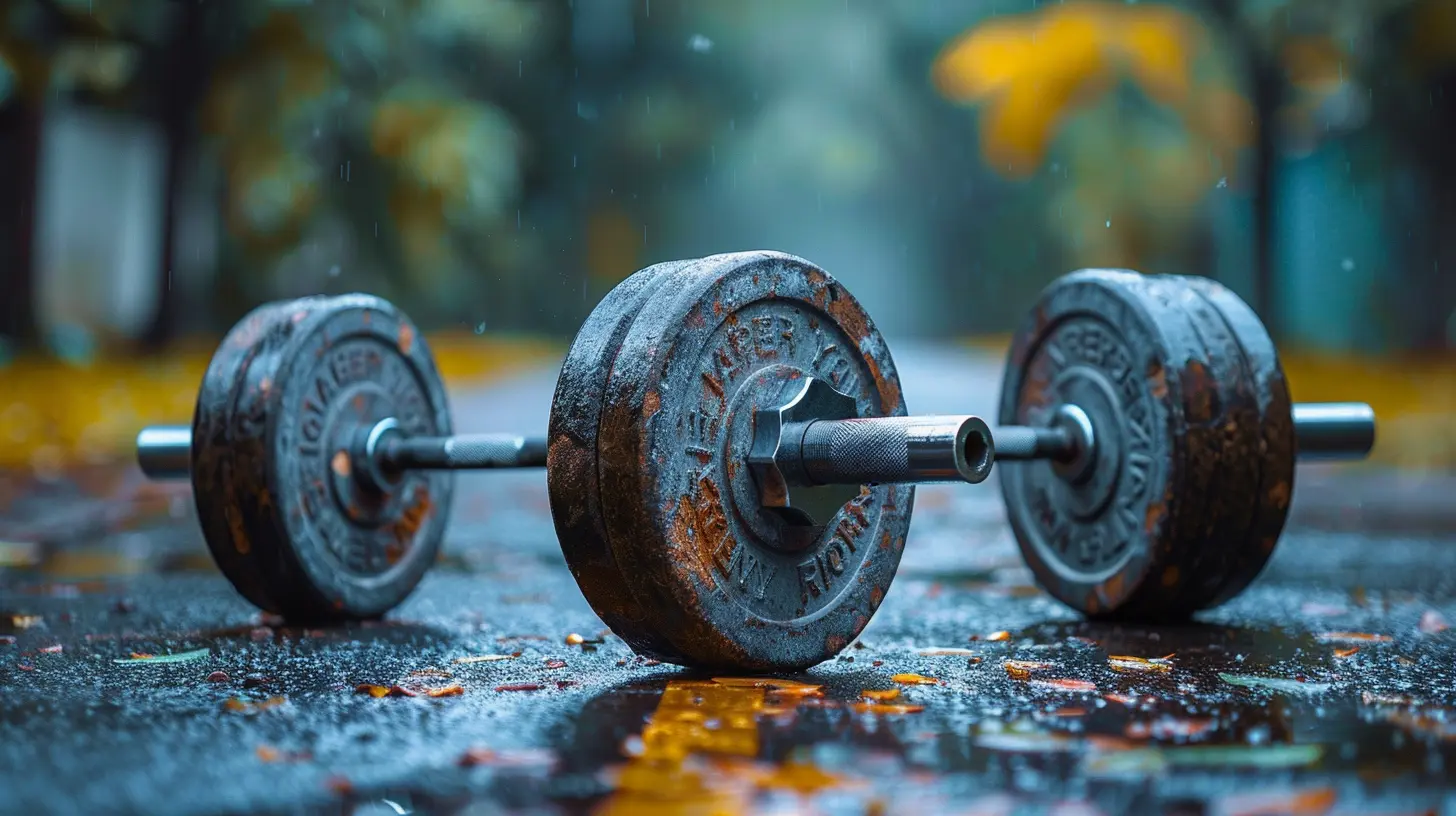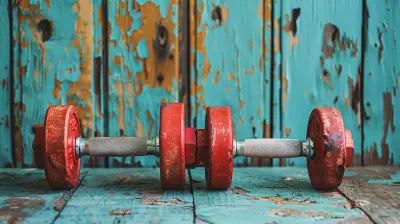High-Rep vs. Low-Rep Training: What’s Best for You?
9 January 2025
When it comes to fitness and strength training, the debate around high-rep vs. low-rep training can feel like a never-ending tug-of-war. It’s easy to get caught up in the confusion, especially if you're just stepping into the gym or you’re revamping your workout routine. Should you be loading up the barbell for fewer reps, or should you grab lighter weights and pump out more repetitions?
Well, here's the deal: both high-rep and low-rep training have their place, and choosing between them often boils down to your specific goals, preferences, and even your body type. Let’s dive into the details and break this down in a way that makes sense (because fitness doesn’t have to be rocket science).
What Are Reps, and Why Do They Matter?
Before we jump into the showdown, let’s clear up a quick question: what exactly are reps? Reps (short for repetitions) are the number of times you perform a specific exercise in one set. For example, if you squat 10 times, you’ve completed 10 reps.Reps matter because they’re a key factor in how you train and what results you get. Think of it like choosing the right lane on a highway. Are you cruising for endurance? Building muscle mass? Or chasing raw strength? Your rep range steers the direction of your gains. 
The Basics: High-Reps vs. Low-Reps
To keep things simple:- High-rep training typically involves lighter weights and performing more repetitions per set, usually in the range of 12-20 or more.
- Low-rep training involves heavier weights and performing fewer repetitions per set, typically around 1-6 reps.
Both approaches target your muscles in different ways, and here’s where it gets interesting. Let’s break it down further.
Benefits of High-Rep Training
1. Build Muscular Endurance
High-rep training is like a marathon for your muscles. You’re not just lifting a weight; you’re teaching your body to keep going even when it's tired. This type of training is great for athletes, runners, and anyone who wants to improve stamina and stay active for longer durations.It’s also the perfect go-to if you're someone who enjoys a good sweat session. Those burning sensations in your muscles? That’s your body saying "thank you" for the endurance boost.
2. Improve Muscle Definition
Ever heard the term "toning"? While it’s a bit of a misleading buzzword, high-rep training can help create that lean, sculpted look. By performing more reps with lighter weights, you’re keeping your muscles under tension for longer, which can help with muscle definition and fat loss.Think of it like chiseling a statue. Patience and effort over time bring out those fine details.
3. It’s Safer for Beginners
If you’re new to lifting, high-rep training is a great way to ease into strength training. Lighter weights are less intimidating and reduce the risk of injury while you focus on nailing your form. It’s like learning to crawl before you walk – slow and steady wins the race.
Benefits of Low-Rep Training
1. Build Raw Strength
If your goal is to lift a truck (or, you know, just get really strong), low-rep training is your ticket. Fewer reps with heavier weights help build maximum strength because you’re teaching your muscles to generate power.This is why powerlifters and strongmen focus almost exclusively on low-rep training—it’s about brute force, plain and simple.
2. Increase Muscle Mass (Hypertrophy)
Wait, doesn’t high-rep training build mass too? Sort of, but here’s the twist: low-rep training with heavier weights stimulates myofibrillar hypertrophy, which emphasizes growing denser, thicker muscle fibers. In simpler terms, you’re adding raw size and strength to your muscles.If you’ve ever wondered how people develop those massive, rock-solid biceps, low reps and heavy weights are probably their secret weapon.
3. Boost Mental Focus
Lifting heavy isn’t just physical—it’s mental. Low-rep training forces you to stay laser-focused and maintain proper form because there’s no room for error. Think of it as a game of chess, where every move is deliberate and calculated.When Should You Do High-Reps?
High-rep training is ideal when:- Your goal is endurance or fat loss. You’ll burn more calories during a high-rep workout because you’re performing more volume.
- You’re short on equipment. Got nothing but a kettlebell or resistance bands? High-rep training lets you maximize your workout even with lighter tools.
- You’re recovering from an injury. Since high-rep training typically involves lighter weights, it's gentler on your joints and allows for safer recovery.
When Should You Do Low-Reps?
Low-rep training is your best bet when:- Your goal is strength and size. If you want to push heavy weights and grow bigger, low-rep training will help you get there.
- You’re an athlete in power sports. Think football, powerlifting, or Olympic lifting. These sports require explosive power, and low-rep training delivers just that.
- You’re looking to mix up your routine. Stuck in a plateau? Switching to low reps can reignite progress and challenge your muscles in new ways.
Can You Combine High-Reps and Low-Reps?
Absolutely! In fact, combining both approaches can be the best of both worlds. Here’s how:- Periodization: This is a fancy way of saying you switch between phases of high-rep and low-rep training depending on your goals or the time of year.
- Hybrid Workouts: Incorporate both methods into the same workout. For example, use low reps for compound lifts like squats and deadlifts, then switch to high reps for accessory exercises like bicep curls or lunges.
Remember, your body loves variety. Mixing things up keeps your muscles guessing and prevents the dreaded plateau.
Still Not Sure? Let Your Goals Decide
Here’s a quick cheat sheet to help you decide:- Goal: Lose Weight or Tone Up? Go high-reps.
- Goal: Build Muscle or Gain Strength? Go low-reps.
- Goal: Be a Well-Rounded Beast? Combine both.
Your goals might even change over time, and that’s totally okay. The key is to listen to your body and adjust accordingly.
Common Myths About Reps
Let’s bust a few myths while we’re here:1. Myth: High-reps make you “toned” while low-reps make you bulky.
- Truth: Muscle tone comes down to body fat percentage and muscle size. Your rep range is just a tool in the process.
2. Myth: Low-reps are for men, high-reps are for women.
- Truth: Strength training doesn’t discriminate. Both men and women can benefit from either approach.
3. Myth: You have to pick one or the other.
- Truth: Why limit yourself? Both styles have their pros, and smart lifters use a mix.
Final Thoughts: What’s Best for You?
At the end of the day, choosing between high-rep and low-rep training isn’t a matter of right or wrong—it’s a matter of what works for you. Your goals, your preferences, and even your mood can sway your decision.Remember, fitness is all about the long game. Whether you’re chasing bigger biceps, a faster mile time, or a leaner physique, the most important thing is consistency. So, grab those weights, get to work, and don’t be afraid to experiment. You might discover you love a little bit of both.
all images in this post were generated using AI tools
Category:
BodybuildingAuthor:

Angelo McGillivray
Discussion
rate this article
12 comments
Yolanda Navarro
Great article! It’s so exciting to explore the benefits of both high-rep and low-rep training. Finding what works for you can transform your fitness journey! 🎉💪
March 23, 2025 at 5:15 AM

Angelo McGillivray
Thank you! I'm glad you enjoyed the article and found the insights helpful! 🎉💪
Maisie McGonagle
Find your strength—both high and low reps can transform you!
February 10, 2025 at 3:29 AM

Angelo McGillivray
Thank you for your insight! Both high and low rep training have unique benefits, and finding what works best for you is key to maximizing results.
Genevieve Bryant
Great overview! Choosing between high-rep and low-rep training ultimately depends on your fitness goals. Tailor your approach to maximize results and prevent injury.
February 3, 2025 at 4:46 PM

Angelo McGillivray
Thank you for your insight! Tailoring training to individual goals is key for achieving optimal results while minimizing injury risk.
Edith Spencer
Great read! Whether you’re team high-rep or low-rep, remember that consistency and enjoying your workouts are key. Mix it up, listen to your body, and celebrate your progress—every rep counts! Keep shining and stay committed to your fitness journey! 💪😊
January 28, 2025 at 5:53 AM

Angelo McGillivray
Thank you for your thoughtful comment! Absolutely agree—consistency and enjoyment are crucial in any training routine. Keep pushing towards your fitness goals! 💪✨
Ariella McIlroy
Forget the debates—both high-rep and low-rep training have their place in a balanced regimen. It's not about one being better than the other; it's about what fits your goals and lifestyle. Embrace variety, listen to your body, and transform your workouts. Your journey is uniquely yours—own it!
January 22, 2025 at 5:30 PM

Angelo McGillivray
Absolutely! Embracing both high-rep and low-rep training allows for a well-rounded approach that aligns with individual goals and needs. Variety is key to progress and enjoyment in fitness!
Asher McIntire
Find what feels right for you!
January 17, 2025 at 4:25 PM

Angelo McGillivray
Absolutely! It's all about personal preference and goals—experiment with both to see what works best for you!
Eva Frank
Individual goals and body responses dictate the effectiveness of high-rep versus low-rep training.
January 14, 2025 at 5:30 PM

Angelo McGillivray
Absolutely! Tailoring your training to your personal goals and how your body responds is key to maximizing results with either high-rep or low-rep training.
Riff McKinley
Great article! I appreciate the clear explanation of high-rep and low-rep training. It's helpful to understand how different approaches can suit individual goals. Looking forward to trying out some of these tips in my routine!
January 12, 2025 at 5:56 PM

Angelo McGillivray
Thank you for your kind words! I'm glad you found the article helpful. Best of luck with your training!
Payton Ortiz
High-rep training boosts endurance, while low-rep builds strength; choose based on your fitness goals.
January 11, 2025 at 4:48 AM

Angelo McGillivray
That's a great summary! Tailoring your training to your specific goals can maximize results.
Giovanna McPhail
This article provides a thoughtful comparison of high-rep and low-rep training. It’s essential to consider individual goals, fitness levels, and preferences. Ultimately, finding a balanced routine that incorporates both can lead to optimal results and sustained motivation.
January 10, 2025 at 4:13 PM

Angelo McGillivray
Thank you for your insightful comment! I completely agree—balancing both high-rep and low-rep training is key to achieving individual fitness goals and maintaining motivation.
Shannon McMaster
This article effectively highlights the strengths of both high-rep and low-rep training. It prompted me to reflect on my own workout routine and consider incorporating more variety.
January 10, 2025 at 4:36 AM

Angelo McGillivray
Thank you for your feedback! I'm glad the article inspired you to consider incorporating more variety into your routine. Variety can be key to achieving your fitness goals!
Trixie McLaury
Great article! Both high-rep and low-rep training have unique benefits, so understanding your goals is key. Remember, it’s not just about the numbers; listen to your body and find what works best for you. Consistency and enjoyment in your routine will lead to lasting results! Keep pushing forward!
January 9, 2025 at 5:59 AM

Angelo McGillivray
Thank you for your thoughtful insight! I completely agree—aligning training with personal goals and prioritizing consistency and enjoyment is essential for success. Keep striving for progress!
MORE POSTS

Cardio and Bone Density: Building Stronger Bones with Exercise

The Science Behind Gratitude and Its Impact on Wellbeing

How to Incorporate Meditation into Your Exercise Routine

Debunking Common Fitness Myths: What Really Works?

The Power of Breathwork for Inner Calm and Focus

The Role of Mental Toughness in Bodybuilding Success

Understanding the Skin Microbiome and Why It Matters

The Role of Sound Healing in Stress Reduction